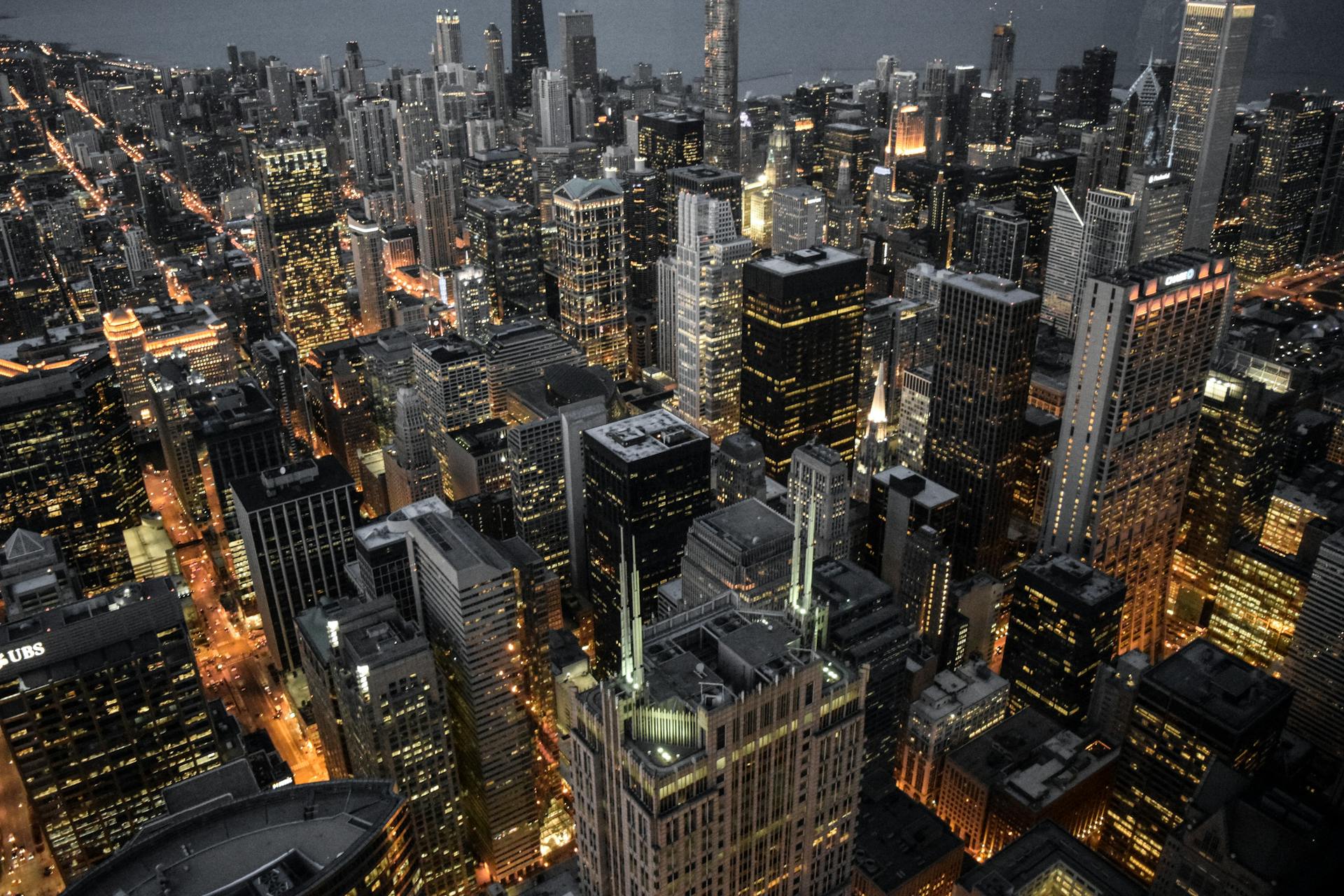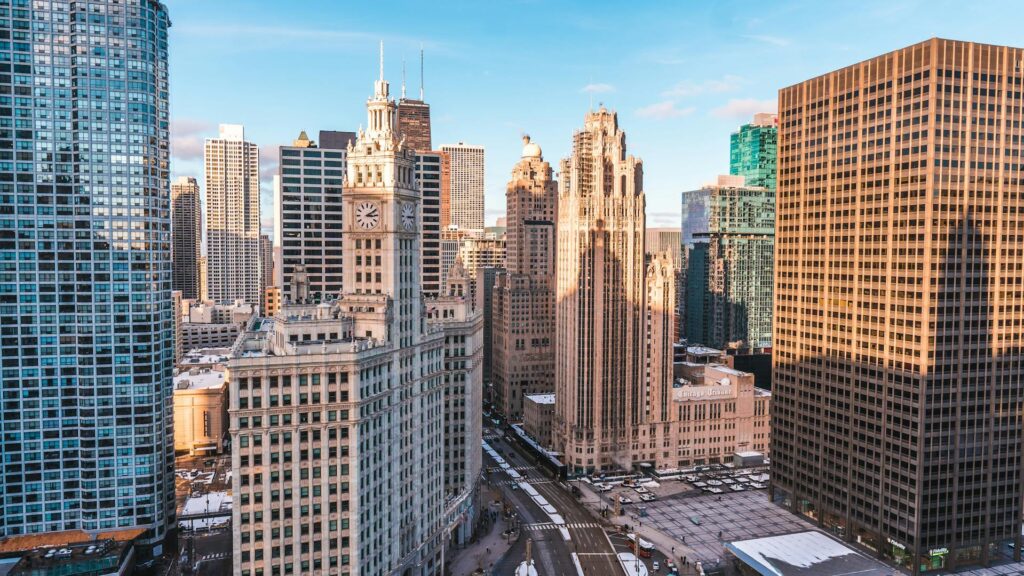Have you ever looked up at the towering giants of downtown Chicago and wondered, “How did this city become the birthplace of the skyscraper?” You’re not alone. Many people are fascinated by how Chicago skyscrapers came to dominate the city’s skyline and change the world’s architectural landscape. It’s a story of innovation, resilience, and a bit of serendipity, all rolled into one. Let’s dive into the fascinating tale of how Chicago became synonymous with skyscrapers.
The Great Fire and a New Beginning
The Great Chicago Fire of 1871 was a pivotal moment in the city’s history. It destroyed more than three square miles of the city, leaving a staggering number of people homeless and businesses in ruins. Yet, it also provided a blank slate for architects and city planners. With the city in ruins, there was an urgent need to rebuild quickly and efficiently, and this urgency gave rise to the innovative spirit that Chicago is known for today.
The fire’s aftermath was a proving ground for architects like Daniel Burnham and John Root, who embraced new materials and construction methods. The use of steel frames, in particular, revolutionized building design. Steel allowed buildings to be taller and sturdier without the thick, heavy walls that had previously been necessary. This shift was pivotal, enabling the construction of skyscrapers that could reach new heights, literally and figuratively. It was during this time that the city became the epicenter of architectural innovation, much like the architecture of Paris has influenced the world in its own unique way.
The Rise of Steel and the Birth of the Skyscraper
Steel-frame construction was the key technological advancement that made skyscrapers possible. Before steel, buildings relied on load-bearing walls to support their weight, which limited their height. Steel changed all that by allowing for a skeleton-like structure that could support much taller buildings. The Home Insurance Building, completed in 1885, is often credited as the world’s first skyscraper, standing at ten stories high. This was a groundbreaking development, as no building had ever reached such heights before.
This new method of construction quickly caught on, and architects began to compete to see who could build the tallest and most impressive structures. The race for the sky was on, and Chicago skyscrapers soon became a symbol of modernity and progress. As the city grew vertically, it set a precedent for skyscrapers worldwide, influencing even places with problematic modern architecture to reconsider their approaches.
The Chicago School of Architecture
The Chicago School of Architecture played a crucial role in the development of skyscrapers. This group of architects focused on creating functional, practical buildings that made the most of new technologies. They emphasized simple lines and minimal ornamentation, which was a stark contrast to the highly decorative styles popular at the time. This focus on functionality over form became a hallmark of Chicago skyscrapers and influenced architectural styles around the world.
Some of the most notable architects from the Chicago School included Louis Sullivan, who famously coined the phrase “form follows function.” Sullivan’s designs were characterized by their simplicity and elegance, and his work laid the groundwork for future architectural movements. It’s fascinating to see how these early principles have influenced not only skyscrapers but also other significant structures like the Sheikh Zayed Mosque design, where functionality blends seamlessly with aesthetic appeal.
Technological Innovations and the Elevator
Another critical innovation that made skyscrapers feasible was the invention of the elevator. Before elevators, buildings were limited to about six stories because people simply didn’t want to climb more than that. The introduction of safe, reliable elevators changed everything. Suddenly, it was possible to build much taller buildings because people could easily reach the upper floors. This innovation was as transformative as the introduction of steel-frame construction.
The elevator opened up new possibilities for architects and developers, allowing them to maximize the use of limited urban space. This technological leap was instrumental in making Chicago skyscrapers a reality and set the stage for other cities to follow suit. It’s interesting to consider how this innovation parallels the profound impact of elevators on other architectural marvels, such as the Sagrada Familia architecture, which also relies on cutting-edge technology to achieve its towering heights.
Economic Growth and Urban Expansion
As Chicago’s economy boomed in the late 19th and early 20th centuries, so did the demand for office space. The city’s burgeoning industries needed a centralized location for their operations, and skyscrapers provided the perfect solution. These tall buildings allowed businesses to cluster together in the heart of the city, fostering collaboration and innovation. As a result, Chicago became a hub for commerce and industry, attracting businesses and workers from across the country.
The economic growth of the city was mirrored in its skyline, as more and more skyscrapers were built to accommodate the influx of people and businesses. This period of rapid urban expansion was both a cause and effect of the city’s vertical growth, and it solidified Chicago’s reputation as a city of skyscrapers. The rise of these towering structures can be seen as a precursor to the St. Peter’s Basilica architecture, which also reflects the intersection of economic power and architectural ambition.
The Influence of the World’s Fairs
Chicago hosted two World’s Fairs in the late 19th and early 20th centuries, both of which had a significant impact on the city’s architecture. The 1893 World’s Columbian Exposition, in particular, showcased the latest advancements in building design and construction. Architects from around the world came to see the innovative techniques being used in Chicago, and many of them took these ideas back to their home countries.
The fairs helped to cement Chicago’s reputation as a leader in architectural innovation and inspired a new generation of architects to explore the possibilities of steel-frame construction and skyscraper design. This influence can still be seen in modern architecture, where the lessons learned in Chicago continue to shape the way buildings are designed and constructed. The impact of these fairs is comparable to the influence of Art Nouveau interior design, which also left a lasting mark on the architectural world.

The Skyscraper and the Modern City
The rise of the skyscraper fundamentally changed the way cities were designed and built. Before skyscrapers, cities were limited by the amount of available land, and growth often meant expanding outward into the surrounding countryside. Skyscrapers, however, allowed cities to grow vertically, making it possible to accommodate more people and businesses in a smaller area. This shift had a profound impact on urban planning and development, leading to the dense, vibrant cities we know today.
Chicago skyscrapers were at the forefront of this transformation, setting a precedent for other cities to follow. The city’s embrace of vertical growth paved the way for modern metropolises around the world, where skyscrapers are now a defining feature of the urban landscape. This evolution is similar to the way church building interior designs have evolved over time, adapting to new technologies and changing cultural needs.
Architectural Styles and the Evolution of Design
The evolution of skyscraper design in Chicago is a testament to the city’s ongoing commitment to architectural innovation. Over the years, Chicago skyscrapers have reflected a variety of architectural styles, from the simple, functional designs of the Chicago School to the bold, expressive forms of modern and postmodern architecture. This diversity has helped to create a dynamic and visually striking skyline that is constantly changing and evolving.
As new materials and construction techniques have become available, architects have continued to push the boundaries of what is possible with skyscraper design. This spirit of innovation is a key part of what makes Chicago’s skyline so unique and is reminiscent of the creative approaches seen in other architectural masterpieces, such as the Sagrada Familia architecture.
The Cultural Impact of Chicago Skyscrapers
Beyond their architectural significance, Chicago skyscrapers have also had a profound cultural impact. These towering structures have become iconic symbols of the city, representing its resilience, innovation, and ambition. They have inspired countless artists, writers, and filmmakers, and have become a source of pride for Chicagoans. The city’s skyscrapers are more than just buildings; they are a testament to the human spirit and the power of ingenuity.
The cultural impact of Chicago skyscrapers can be seen in the way they have influenced other cities around the world. As other urban centers have sought to emulate Chicago’s success, they have adopted similar approaches to skyscraper design and construction. This cultural exchange has helped to shape the global architectural landscape, much like the influence of Art Nouveau interior design on modern design trends.
Skyscrapers and the Future of Chicago
Looking ahead, the future of Chicago skyscrapers is bright. As the city continues to grow and evolve, so too will its skyline. New developments are constantly underway, with architects and developers striving to create innovative and sustainable designs that meet the needs of the modern city. These new skyscrapers will undoubtedly build upon the legacy of their predecessors, continuing to push the boundaries of what is possible.
The future of Chicago’s skyline is a testament to the city’s enduring spirit of innovation and creativity. As new challenges and opportunities arise, the city will continue to adapt and thrive, much like the way church building interior designs have evolved to meet the changing needs of their communities.
The Global Influence of Chicago Skyscrapers
The influence of Chicago skyscrapers extends far beyond the city’s borders. As other cities have looked to Chicago for inspiration, they have adopted similar approaches to skyscraper design and construction. This global exchange of ideas has helped to shape the architectural landscape of cities around the world, creating a shared language of design that transcends cultural and geographical boundaries.
The global impact of Chicago skyscrapers can be seen in the way they have inspired other iconic structures, such as the towering wonders found in the top 15 architectural wonders of the 21st century. This cross-pollination of ideas has helped to create a rich and diverse architectural tapestry that continues to evolve and grow.
Conclusion
Chicago skyscrapers are more than just towering structures; they are a testament to the city’s resilience, innovation, and ambition. From the ashes of the Great Fire to the heights of modern architectural achievement, the story of Chicago’s skyscrapers is a fascinating journey of creativity and determination. As the city continues to grow and evolve, its skyline will undoubtedly remain a symbol of progress and inspiration for generations to come. Whether you’re gazing up at these giants from the streets below or admiring them from afar, it’s clear that Chicago’s skyscrapers are here to stay, shaping the future of urban landscapes worldwide.

Recent Posts
15 Floor Plan Graphic Styles That Will Elevate Your Presentation Game
The Role of Shadows in Architectural Storytelling
When Furniture Becomes Architecture: Blurring the Line